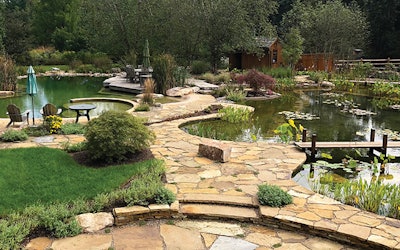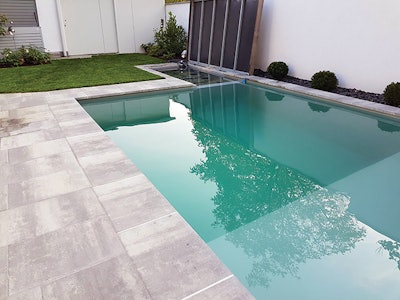
The first natural swimming pools in the U.S. were installed back in 2013, receiving widespread coverage in AQUA and other media outlets. The idea of using systems that mimic nature to clean and purify pool water was, and remains, an intriguing concept.
Those pools used a system originally developed in Europe by Rainer Grafinger of Germany's BioNova, which cleans pool water using a "regeneration zone" instead of chemicals. The regeneration zone is a secondary pond, roughly the size of the swimming pool, that contains plants, gravel and sand. In the regeneration zone, beneficial microorganisms process nitrogen- and phosphate-based compounds to prevent algae and the development of colonies of harmful pathogens. In essence, the regeneration zone acts as a large biological filtering system that returns treated water to the pool.
Since 2013, this system has provided the water care regime for hundreds of NSP installations throughout Europe and approximately 100 installations in North America. BioNova reports it now has a dozen builder/ dealers on its U.S. roster actively promoting, designing and installing these natural swimming pools.

All photos courtesy of BioNova
BioNova sees slow and steady growth in acceptance of NSPs, with Europe well ahead of the U.S., partly due to cultural factors.
RELATED: Natural Swimming Pools: More Beauty, No Chemicals
"It's fair to say that in North America the world of NSPs is at an infantile, maybe even embryonic, stage of development, while Europe has been installing since the early '80s," says Allen Schnaak, the company's vice president of dealer development.
BioNova is pushing to educate both professionals and consumers about NSPs, as the company's market research indicates a lack of knowledgeable resources as the number-one reason potential buyers have stepped back.
"It's ironic in this day and age that a lack of knowledge about NSPs is the primary challenge. We get 80% of our leads online from people who are drilling through all the different information they find through search engines, but it's confusing with all sorts of inaccurate and conflicting messages. That's why we're working to raise awareness. We want everyone to know that the ability to create naturally purified water is real."
 Natural swimming ponds require a regeneration zone that is similar in size to the swimming vessel itself. Because biofilm reactors eliminate the need for a regeneration zone, they reduce the amount of space required.
Natural swimming ponds require a regeneration zone that is similar in size to the swimming vessel itself. Because biofilm reactors eliminate the need for a regeneration zone, they reduce the amount of space required.
All photos courtesy of BioNova
Schnaak also reports that sustainability is a primary motivator for potential buyers, not an aversion to chemically treated pools.
"We did a survey of more than 2,400 potential customers and over 70% identified sustainability as one of their top three motivating factors. Anti-chemical comments were way down on the list.
"It's a better platform to market from," he adds. "The millennials are building the brand of sustainability. Natural ponds and aquatic vegetation speak to a serene zen, Walden Pond kind of quality. There's a marketplace of people seeking that. Then there's a marketplace of people who are swimming enthusiasts and just want the option of swimming in naturally pure water. And there are those who cross over between both categories."
BIOFILM REACTORS
The most significant recent development in NSP methodology is the "biofilm reactor." In essence, a biofilm reactor does the work of the regeneration zone in a much smaller space.
"A biofilm reactor is a container located next to the pool that has certain structures and materials that encourage the growth of biofilm over an increased surface area," says James Robyn, president and CEO of BioNova's U.S. company. "This is where the work of the NSP takes place. You will, for example, reduce phosphate levels to below 10 ppb. At that level, algae will not grow. The water is absolutely clear and you often cannot tell the difference between an NSP or a chemically treated body of water. That's because all of that biofilm growing in the reactor is consuming all of the nutrients in the water.
"It runs 24/7 so it's constantly feeding the nutrients in the water to the biofilm in the reactor. In a very real sense, the pool functions like a living organism. If you cut off the food supply it will die, so we run it all the time, which means it's constantly stripping the nutrients from the water. It's a low-pressure system so it doesn't require much energy. There's no pressurized filtration."
RELATED: Swim Ponds vs Natural Swimming Pools - Two Sides of the Same Coin
Biofilm reactors are common in other, often more demanding applications such as wastewater management and treating water for fermentation processes. Robyn and company recognized an opportunity to use them in NSPs as a way to grow and maintain beneficial bacteria colonies.
BioNova recently entered into an arrangement with package pool manufacturer Cardinal Pools to create a line of pools that includes the vault for installing a biofilm reactor.

All photos courtesy of BioNova
BENEFICIAL BACTERIA
Whether the purification process takes place in a biofilm reactor or a regeneration zone, the same principles apply. One of the most important aspects of the NSP concept is how the systems control the growth of pathogens such as E. coli, pseudomonas, giardia and the now infamous cryptosporidium, which has proven almost immune to chlorine treatment.
"One of the beauties of the biome created in a natural swimming pool is the beneficial microorganisms will out-compete pathogens for nutrients," Robyn explains. "In a sedimentation filter system, the zooplankton will consume cysts such as giardia and cryptosporidium. But in the biological system that exists in a biofilm reactor, pathogens are overwhelmed by the biofilm and have no opportunity to develop. Pathogens are simply outnumbered and nothing is going to survive when it doesn't have the means to survive."
"It's how nature does it," Schnaak adds. "We didn't invent natural water, no one can make that claim, God did it a long time ago. All we're doing is identifying those natural processes and using them to treat swimming pools. That approach isn't for everyone, but we do believe that it will appeal to consumers looking for a different option that is based on natural, environmentally sustainable choices."












































